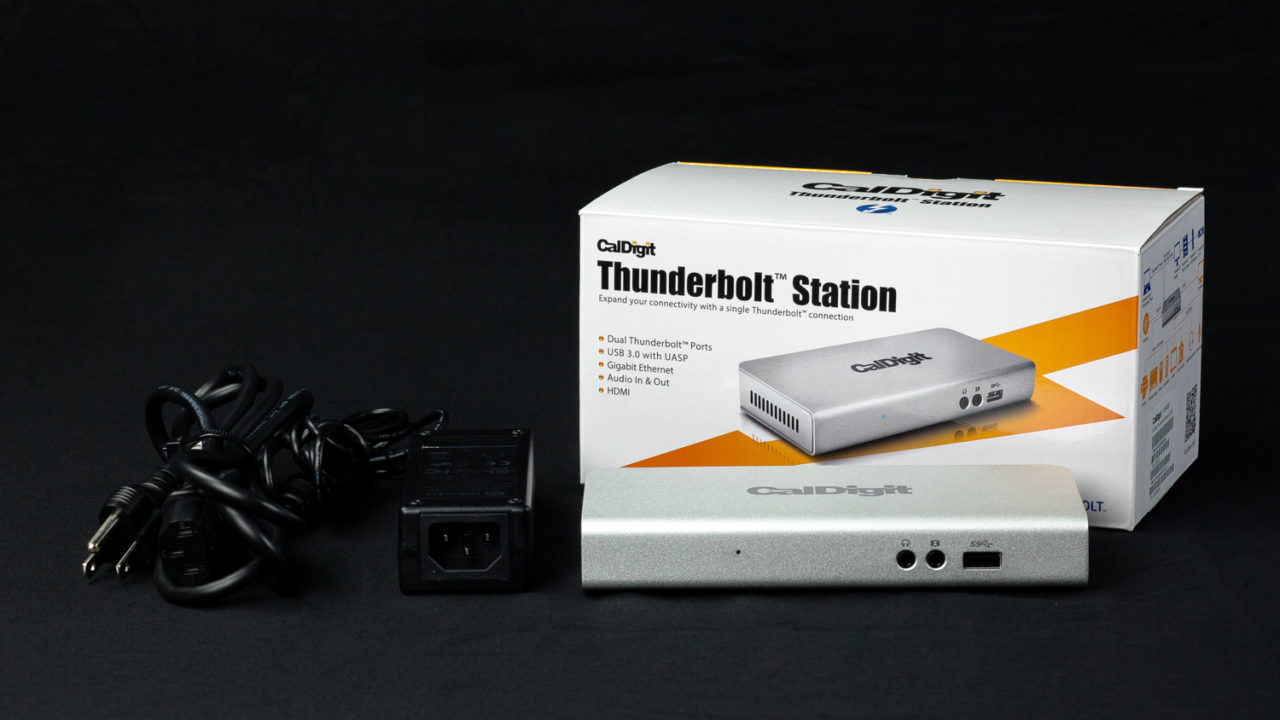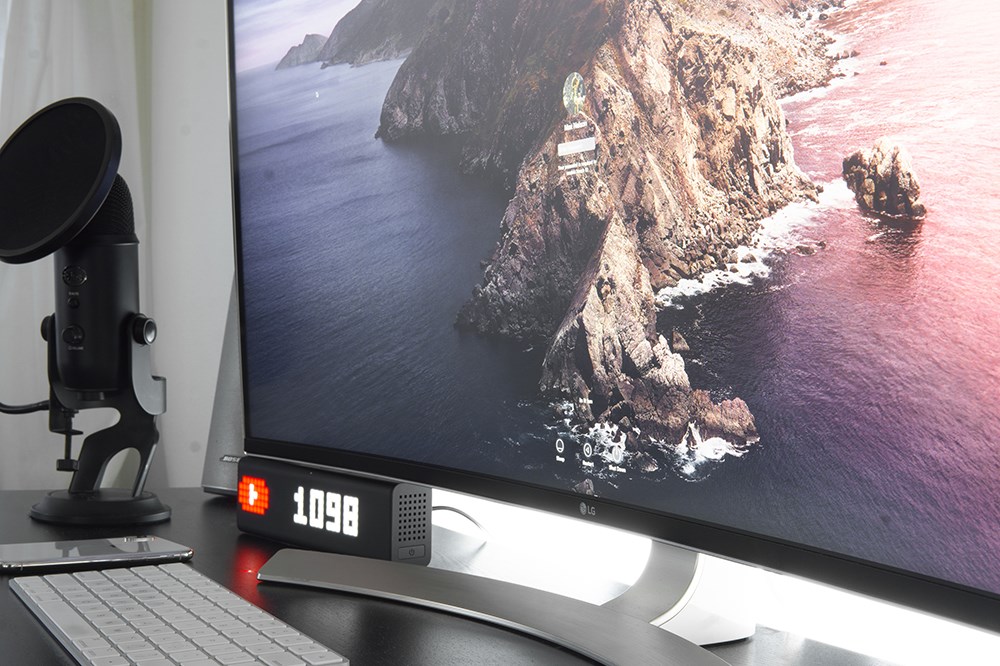The CalDigit Thunderbolt Station

When Thunderbolt was first introduced, it promised far more than just a faster method of connecting external hard drives. The integration with DisplayPort and ability to handle networking and audio in addition to data transfers made many enthusiasts excited about the possibilities of powerful new docking stations and other robust applications.
Unfortunately, Thunderbolt proved more difficult to master than manufacturers thought, and many Thunderbolt-based products have been delayed, lost key features, or been outright canceled. One of the earliest Thunderbolt docks, the Belkin Thunderbolt Express Dock, went through several revisions after its unveiling, losing features like eSATA support and full-speed USB 3.0. In our review of the product earlier this year, we found the dock to be solid overall, but we experienced some technical issues that required a replacement of our review unit.
The CalDigit Thunderbolt Station is the most stable Thunderbolt dock we’ve tested, and that’s an important victory in and of itself
Another early dock, the Matrox DS1, also received generally positive reviews, but it is missing key features like FireWire 800 support and Thunderbolt Passthrough. Perhaps the most interesting dock is the Sonnet Echo 15, which incorporates internal hard drives and a Blu-ray player, but that product has been delayed for months, with no definitive launch date in sight.
It is within this atmosphere of disappointment and delays that storage firm CalDigit has decided to enter the fray. The company recently released the CalDigit Thunderbolt Station, and we’ve spent the past few weeks integrating it into our workflow. While it’s not the perfect dock for our needs, we’re happy to report that it performs exactly as promised, and it’s the most stable Thunderbolt dock we’ve tested to date.
The Good
Let’s start on a positive note and discuss all the things we like about this new CalDigit Thunderbolt Station.
USB 3.0: There’s no lowly USB 2.0 to be found. Like the Belkin dock, but unlike the Matrox dock, the CalDigit Thunderbolt Station features three USB 3.0 ports. A unique feature of the CalDigit, however, is that all three ports provide full-speed USB access. The Belkin’s USB 3.0 ports were limited to 2.5Gbps, while the CalDigit features full 5Gbps with UASP (USB attached SCSI) support. We tested each port individually with a USB 3.0 SSD (a 120 GB Samsung 840 EVO inside an Anker USB 3.0 enclosure), and each port provided the same impressive performance, giving us an average of 350 MB/s reads and 320 MB/s writes, the same speeds we attained when the drive was connected to a native USB 3.0 port.
Thunderbolt Passthrough: The CalDigit Thunderbolt Station provides two Thunderbolt ports, enabling passthrough to a display or other Thunderbolt device. Even better, both ports are on the back of the device, allowing for a clean desk with all wires routed to the rear of the Dock. The Thunderbolt passthrough works similarly to that of other passthrough devices. Devices further down the Thunderbolt chain work just fine, but they will see a performance reduction if devices higher on the chain are involved in bandwidth-intensive tasks, such as using the Dock’s USB 3.0 ports to perform large file transfers.
HDMI Support: Users can always connect a display using the second Thunderbolt support, but the CalDigit dock also includes a dedicated HDMI port. If your monitor supports HDMI, this can free up the second port for additional Thunderbolt devices. Alternatively, you can utilize both Thunderbolt and HDMI to provide a dual-display setup. We tested this by connecting a 1080p Panasonic Plasma TV to the HDMI port and an Apple Thunderbolt Display to the second Thunderbolt port. Both displays were seen by our test MacBook Pro, and both worked without a hitch.
Gigabit Ethernet: Every Thunderbolt Dock we’ve seen has gigabit Ethernet support, so it’s nice to see the CalDigit continue the tradition, especially considering the lack of Ethernet ports on modern MacBooks. Our testing revealed no issues, and we were able to achieve full gigabit speeds of about 110 MB/s on our local network.
The Design: All of the above technical features are great, but the CalDigit Thunderbolt Station also looks great, too. It’s relatively small and lightweight, weighing in at about 0.8 pounds, but it feels very sturdy and well-assembled. The body is made of beautiful aluminum that matches the color and texture of modern Macs, and the dock looks great sitting on a desk next to a MacBook or iMac. Beyond looks, the dock stayed cool and quiet during all of our testing.
The Price: Thankfully, the CalDigit dock is relatively easy on the wallet. Although many would argue that all Thunderbolt products are grossly overpriced, the dock’s $199 MSRP is reasonable compared to similar options.
The Bad
Not everything is perfect, however. While the CalDigit Thunderbolt Station performs its advertised functions very well, we find that the device doesn’t meet all of our must-haves for a Thunderbolt dock. FireWire 800, for example, has been a huge part of the Apple ecosystem for many years, and we have tons of FireWire drives and devices that we’d like to be able to use natively with the dock. Sure, we could always connect a Thunderbolt to FireWire adapter to the dock’s second Thunderbolt port, but it would be far cleaner to have the capability built in to the product.
Make sure you remember to pick up an extra Thunderbolt cable if you need one
The same thing can be said of eSATA. While eSATA is not nearly as ubiquitous as FireWire, CalDigit is primarily known for its professional-grade storage solutions, and media professionals in particular could surely have taken advantage of eSATA compatibility.
Finally, and this is a pet peeve of ours, the CalDigit dock does not include a Thunderbolt cable, a trend we’ve noticed with Thunderbolt docks. We certainly understand the economics behind the decision, especially in light of how much Thunderbolt cables cost compared to cables for other technologies, but it’s unfortunate that products are still shipping today without the necessary cables in the box. With this in mind, you’ll have to factor in the cost of a Thunderbolt cable with the dock’s price, unless you have a spare already on hand.
Update: as pointed out in the comments, CalDigit offers a “bundle” version of the Thunderbolt Station with a 0.5 meter Thunderbolt cable for $218. This represents a roughly $10 savings over buying a 0.5 meter Apple Thunderbolt cable separately. However, it’s important to clarify that this is a retail “add-on;” there is no Thunderbolt cable in the box and none is included at the device’s standard $199 MSRP.
The Verdict
Regardless of any missing features, the CalDigit Thunderbolt Station is the most stable Thunderbolt dock we’ve tested, and that’s an important victory in and of itself. During our multi-week testing period, we connected a variety of displays, external hard drives, thumb drives, and adapters to the CalDigit dock, and everything worked as expected. No freezes, no need to power cycle, it just worked.
That said, we wish the product incorporated a wider variety of ports. Most consumers will be fine with the port selection on the CalDigit Thunderbolt Station, but the Thunderbolt market is still primarily a prosumer and professional one, and the lack of FireWire and eSATA means that we’d pass on the device if purchasing for ourselves.
But don’t let that assessment stop you. If you are primarily looking for USB 3.0 and networking support, the CalDigit is the only Thunderbolt dock that we can clearly recommend at this point. The other products on the market either lack too many features or suffer from functionality issues. So if you’re looking to add some more ports to a new MacBook Air or, more interestingly, if you’re looking to add USB 3.0 support to 2011-era Macs, the CalDigit Thunderbolt Station might be just what you’re looking for.
You can purchase the CalDigit Thunderbolt Station for $199 now from CalDigit’s online store or via third-party retailers like Amazon, although many retailers are currently sold out with more stock on the way. CalDigit references a one-week backorder on their own online store. If you do decide to purchase one, just make sure you remember to pick up an extra Thunderbolt cable.

















5 thoughts on “The CalDigit Thunderbolt Station”
Plus, manufacturers often bundle the cheapest one that’ll do the job, I’m fussy and prefer to buy from makes I trust, and often this is the reason I don’t use supplied cables, I’m still using my ‘favourite’.
As for the dock, excellent stuff, the only issue I see is that the Apple TB display has a Magsafe connector, and whilst this chap is used my MBP is plugged into its brick. I kind of see the point about firewire, but it seems pretty obvious that Apple is intent on FW going the way of the Dodo, so may as well get used to it. Let’s be frank, here, Apple just makes the decisions, seldom seems to listen to its punters.
That said, I can still remember the outcry when they dropped FDDs and more recently DVD drives, when really few people were actually even using them…and now the new Mac Pro has no upgradable PCI slots, and the Windows fanboys are again in outrage. Apple innovate, I like that, and I like their products…their approach has led the way in most areas of consumer electronics for years.
FW 800 wasn’t really widely adopted, and I think ubiquitous, ‘speedier’ USB3 ended its hopes. I just hope that Thunderbolt1/2 get greater adoption, it is definitely the way ahead…
Even though the station and my connected hdd have their own power supply,
both mine and my girlfriend’s brand new MBA’s only last about 4-5 hours when connected.
This is only a small practical inconvenience, but I’m afraid it will ruin our batteries….
What is your view on this ?
That’s really interesting. We honestly never thought to test battery life because we’re always using docks at our desk, where the power supply is readily available. But CalDigit hasn’t sent us the return shipping info yet, so we’ll try to get a round of battery life tests in before we return the dock. We don’t have a MacBook Air, but we’ll test with a MacBook Pro and update this article with the results.
Looking fwd to your test !
We tested idle battery life while connected to the CalDigit Thunderbolt Dock on a 2011 MacBook Pro. Our Mac is older and doesn’t have a perfect battery, but we got about 4 hours and 45 minutes of battery life while connected to the Dock, and a little over 5 hours when not connected. So there is definitely some power draw happening over the Thunderbolt cable, but it’s not too serious (about 5 percent). If you’re seeing much more of a drain than this, there might be something else going on hardware-wise.
Tx for taking the time to test it guys, really cool !
Well it’s definitely not the macbooks as they’re both new, and my friend’s 2011 model had the same problem. I did however discover the problem thanks to a tester on a popular video channel.
The problem occurs when connecting a 1080p resolution lcd tv through hdmi.
The hd5000 has to drive two displays, and the higher the resolution of the second display, the more it drains the battery….We’ll now see if this has a damaging effect on the devices, and I’ll surely tell you about it if so….see you in a couple of months and thank you !
The only problem I have with the CalDigit Thunderbolt Station is that you cannot have TWO non-Thunderbolt monitors on it. That would have been a fantastic feature. I wanted to get away from using USB-DVI adapters when using a second non-Thunderbolt monitor.
Unfortunately, you are forced to use a Thunderbolt monitor if you want two monitors. And Apple is the only one making a Thunderbolt monitor – a very expensive monitor on top of that.
Note that CalDigit does sell the Thunderbolt Station BUNDLED with a Thunderbolt Cable (0.5 m long). This costs about $215 on their website. Thus, the article is incorrect.
Thunderbolt Cables are expensive since they actually have an electronic chip inside them making them active participants in processing the data. They are not passive easy to manufacture cables.